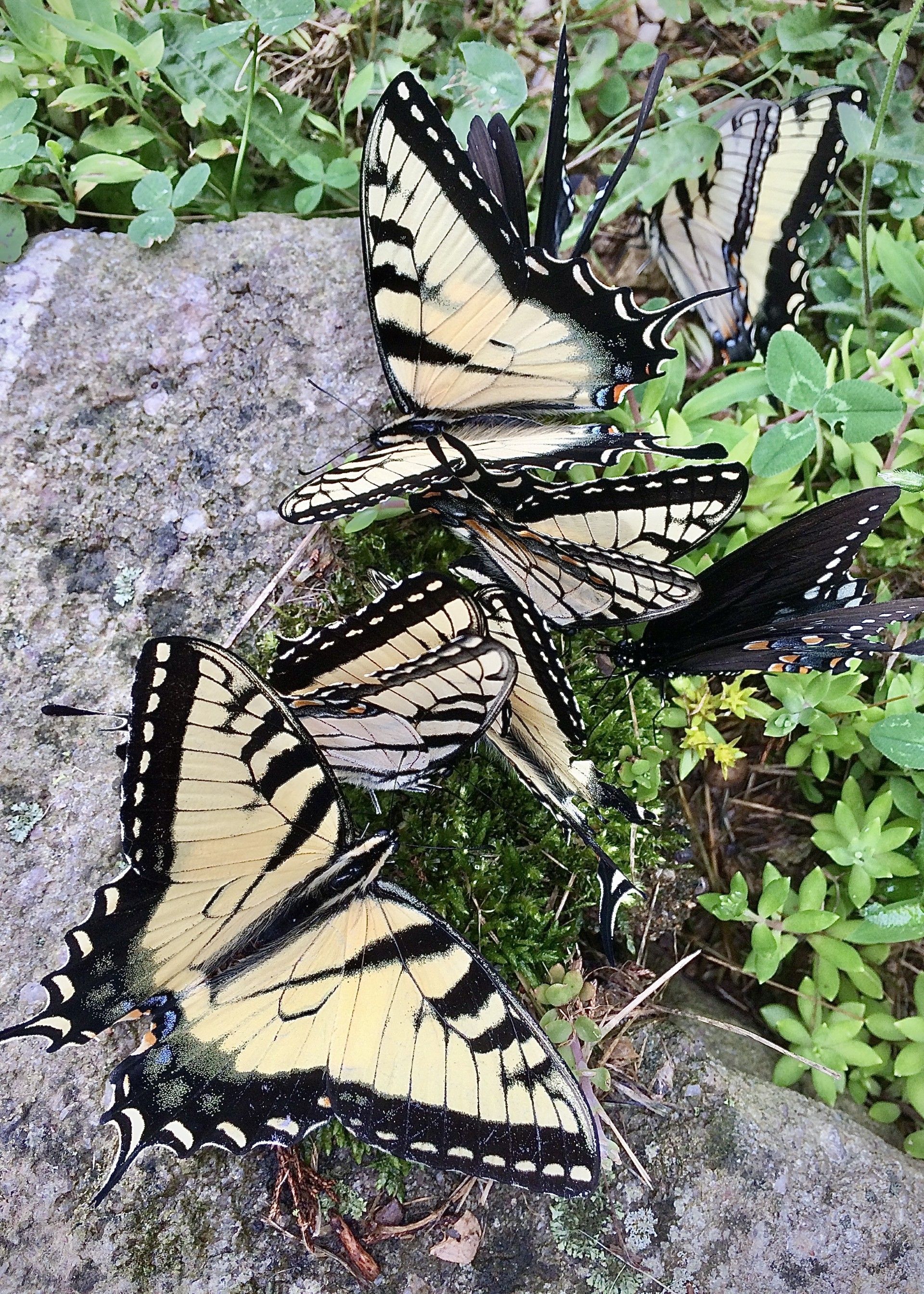"What on Earth?"
Articles and Photos by Ray Barbehenn
Sparkling green sweat bees, such as in the left photo, are beautiful when admired up close. However, a more common response from people tends to be, "Why are these little bees landing on my skin?! Shoo! Shoo!" sweat bees are practically harmless, but they are persistent. This one was about a centimeter long and was observed on May 8 in Duke Hollow (northern Virginia near the AT). Its stout tongue was extended, looking like a bent leg below its head, and was lapping the surface of my hand.
Swallowtail butterflies are another example of insects that are attracted to certain places for the same reasons as the sweat bees. They present a similar mystery: "Why are all of these butterflies licking the ground? Why aren't they on flowers?" The swallowtails are attracted to deposits of urine and other animal products. They are also attracted to the moist edges around puddles, and, hence, the term "puddling." The Tiger Swallowtails and dark Spicebush Swallowtail in the right photo were seen on June 5, 2017 in Duke Hollow. (In this case they were attracted to a man-made "puddle.") Surprisingly, these butterflies are probably all males! (Read on to find out why that makes sense.)
Why do some insects feed on body fluids (sweat, urine, etc.)?
A. They need the water.
B. They sense the small amounts of sugar in them.
C. They are attracted to their fragrances.
D. They need to obtain salt.
E. Unknown.
The answer is at the bottom of the page!
Fun Facts and Musings
First and foremost, for those of us who are frightened by bees, it is great to know that sweat bees are not a threat. The sting of the female is little more than a pin prick, and a pin prick that is not easily provoked.
Sweat bees may be small but they represent the second largest family of bees, with over 4500 species worldwide, including 500 species in the United States. For those who know what the mineral halite is, the family name of sweat bees (Halictidae) provides a strong clue to their attraction to sweaty skin: "hal-" refers to salt! It is not known why sweat bees have a particular need for salt, though this is also seen in bees from other families, including honey bees. Between hikers, sweat bees spend their time foraging for pollen and nectar in flowers – food sources that are particularly low in salt. Thus, sweat (or other body fluids) appears to be a minor, but important, supplemental food source.
Far more research has been done on the puddling behaviors of butterflies and moths than bees. Indeed, butterfly puddling was a cover story in the highly prestigious research journal "Science" back in 1974. It was established that swallowtails are attracted to salt (specifically sodium) and not simply drinking water from puddles. In the following 50 years, there have been several hypotheses to explain this behavior further, but one fact demanded attention: Almost all of these butterflies are males. There has been some support for the idea that the extra boost of sodium allows male butterflies to court females more successfully. Perhaps they fly better and become more attractive to females?
Another hypothesis is that the extra sodium obtained by males helps the females to have more successful offspring. Strange as it may seem, this idea has the most support. It turns out that much of the extra sodium obtained by the male butterflies is concentrated in their tiny sperm packets ("spermatophores"). A spermatophore can contain over half of the sodium content in a male's body! When a spermatophore is transferred to a female during mating, she absorbs its sodium. Not only that, but much of the sodium is then incorporated into her eggs. Since the leaves on which caterpillars feed have little sodium, the salt from puddles ends up providing a precious nutrient for the young caterpillars! Of course, many questions remain unanswered. For example, why don't the female butterflies just puddle with the males?
Insects and other animals are salty creatures – their proverbial blood, sweat, tears, and other body fluids are all salty. Maintaining the right salt balance is essential for a multitude of purposes, including the functions of muscles and nerves. (Thankfully, it is beyond the scope of this article to explain these processes in further detail.) Suffice it to say, we hear a lot about replacing and maintaining our "electrolytes." Sodium is the major electrolyte that is so often referred to, but potassium and several other minor electrolytes are also required. Many athletes and hikers have experienced muscle (or "heat") cramps. These can be caused by muscle fatigue, but the loss of sweat and its salts are also causes in warm weather.
Sodium and other electrolytes are also lost in urine, the result of the filtering of the blood by the kidneys. Insects do not sweat, but they do have tiny versions of kidneys (the "Malpighian tubules") and a need to maintain their electrolyte balances, just like other animals. Given the need of animals to maintain their electrolyte supplies, it is not so odd that even grazing animals, such as cows and deer, are attracted to salt licks; their food, like that of caterpillars, is particularly low in sodium (salt). The tongues of many animals, including ourselves, have a special taste for salt – a testament to our need for it. (As an aside, it is now known that the various tastes are sensed all over the tongue, not just in specific regions, as most of us were taught in school!) However, we do not have a good sense of when more is not better. Our average salt consumption is 3.5 grams a day, which is literally 10-times more than we need. It is no surprise that swallowtail butterflies are attracted to our puddles.
Answer: D!
Send your photos and ideas for topics to Ray at rvb@umich.edu.


